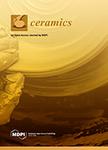首页 > SCI期刊 > SCIE期刊 > JCRQ1 > 期刊介绍

评价信息:
影响因子:2.7
年发文量:146
《瑞士陶瓷》(Ceramics-switzerland)是一本以Multiple综合研究为特色的国际期刊。该刊由Multidisciplinary Digital Publishing Institute (MDPI)出版商该刊已被国际重要权威数据库SCIE收录。期刊聚焦Multiple领域的重点研究和前沿进展,及时刊载和报道该领域的研究成果,致力于成为该领域同行进行快速学术交流的信息窗口与平台。该刊2023年影响因子为2.7。CiteScore指数值为3。
Ceramics Switzerland covers the scientific field of advanced ceramic materials. It encourages the publication of research results that demonstrate how understanding of fundamental chemical and physical phenomena can guide material design and inspire new or improved processing techniques to obtain materials with desired structural features and properties. Pay special attention to the fundamental scientific aspects related to the entire development scope of advanced ceramics, such as phase equilibrium and transformation, reactivity, transport processes, thermodynamics and electronic properties, as well as quantum effects in low dimensional materials. The preferred materials and areas of interest include advanced ceramics and composite materials for civilian, military, and industrial applications at room and moderate temperatures; High temperature and ultra-high temperature structural ceramics and composite materials used in extreme environments; Electric ceramics, such as dielectric and microwave ceramics, ferroelectric materials, piezoelectric materials, thermoelectric materials, and ferroelastic materials; Magnetic, multiferroic, semiconductor, and fast ion conductive ceramics; High temperature superconductors and topological insulators; Optical ceramics, including luminescent and color developing materials.
The materials involved include oxide and non oxide ceramics, functional glass, glass ceramics, amorphous inorganic non-metallic materials (as well as their combinations with metals and organic materials), in the form of particles, dense or porous bodies, thin/thick films, laminates, gradients, and composite structures. Topics related to craftsmanship, such as ceramic ceramic connections or connections between ceramics and different materials, as well as surface treatment and adjustment, are also covered within its scope. In addition to traditional processing techniques, the journal also focuses on innovative manufacturing routes that benefit from external stress, electromagnetic fields, and energy beams, as well as top-down and self-assembled nanotechnology methods.
《瑞士陶瓷》涵盖了先进陶瓷材料的科学领域。它鼓励发表能够展示对基本化学和物理现象的理解如何指导材料设计,并激发新的或改进的加工技术思路的研究成果,以获得具有所需结构特征和性能的材料。特别关注与先进陶瓷的整个发展范围相关的基础科学方面,例如相平衡和转变、反应性、传输过程、热力学和电子性能,以及低维材料中的量子效应等。优先考虑的材料和感兴趣的领域包括:在室温和中等温度下用于民用、军事和工业应用的先进陶瓷和复合材料;用于极端环境的高温和超高温结构陶瓷和复合材料;电陶瓷,如介电和微波陶瓷、铁电体、压电体、热电体、铁弹性体;磁性、多铁性、半导体和快离子导电陶瓷;高温超导体、拓扑绝缘体;光学陶瓷,包括发光和显色材料等。
其涉及的材料包括氧化物和非氧化物陶瓷、功能玻璃、玻璃陶瓷、无定形无机非金属材料(以及它们与金属和有机材料的组合),形式有颗粒、致密或多孔体、薄/厚膜以及层压、梯度和复合结构等。与工艺相关的主题,如陶瓷-陶瓷连接或陶瓷与不同材料的连接,以及表面处理和调节等也在其涵盖范围内。除了传统的加工技术,该期刊还关注受益于外部施加应力、电磁场和能量束的创新制造路线,以及自上而下和自组装的纳米技术方法。
如果您需要协助投稿或润稿服务,您可以咨询我们的客服老师。我们专注于期刊投稿服务十年,熟悉发表政策,可为您提供一对一投稿指导,避免您在投稿时频繁碰壁,节省您的宝贵时间,有效提升发表机率,确保SCI检索(检索不了全额退款)。我们视信誉为生命,多方面确保文章安全保密,在任何情况下都不会泄露您的个人信息或稿件内容。
JCR分区等级:Q1
| 按JIF指标学科分区 | 收录子集 | 分区 | 排名 | 百分位 |
| 学科:MATERIALS SCIENCE, CERAMICS | ESCI | Q1 | 7 / 31 |
79% |
| 学科:MATERIALS SCIENCE, MULTIDISCIPLINARY | ESCI | Q3 | 238 / 438 |
45.8% |
| 按JCI指标学科分区 | 收录子集 | 分区 | 排名 | 百分位 |
| 学科:MATERIALS SCIENCE, CERAMICS | ESCI | Q2 | 13 / 31 |
59.68% |
| 学科:MATERIALS SCIENCE, MULTIDISCIPLINARY | ESCI | Q3 | 267 / 438 |
39.16% |
| Gold OA文章占比 | 研究类文章占比 | 文章自引率 |
| 100.00% | 90.41% | |
| 开源占比 | 出版国人文章占比 | OA被引用占比 |
名词解释:JCR分区在学术期刊评价、科研成果展示、科研方向引导以及学术交流与合作等方面都具有重要的价值。通过对期刊影响因子的精确计算和细致划分,JCR分区能够清晰地反映出不同期刊在同一学科领域内的相对位置,从而帮助科研人员准确识别出高质量的学术期刊。
| CiteScore | SJR | SNIP | CiteScore 指数 | ||||||||||||
| 3 | 0.402 | 0.921 |
|
名词解释:CiteScore是基于Scopus数据库的全新期刊评价体系。CiteScore 2021 的计算方式是期刊最近4年(含计算年度)的被引次数除以该期刊近四年发表的文献数。CiteScore基于全球最广泛的摘要和引文数据库Scopus,适用于所有连续出版物,而不仅仅是期刊。目前CiteScore 收录了超过 26000 种期刊,比获得影响因子的期刊多13000种。被各界人士认为是影响因子最有力的竞争对手。
历年IF值(影响因子)
历年引文指标和发文量
历年自引数据
若用户需要出版服务,请联系出版商。